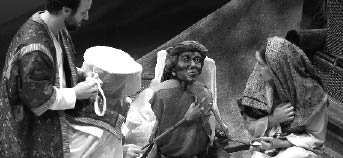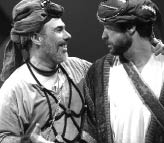Wise Man's a Wise Move
by Anthony Chase

The opening night for the Studio Arena production of The 4th Wise Man by Kathleen Gaffney and Tom Fontana was unusually exciting. The show has been awaited with great anticipation, and Studio Arena made an effort to give the event the air of a special occasion. More people than usual lingered for the party afterward.
Beloved of Buffalo, native son Fontana has given our city plenty to kvell about over the years. His work on television has earned him Emmys and Peabodys for such shows as St. Elsewhere and Oz. His work for the theater has been more modest, but at the national level, theater, television and film overlap. Indeed, Studio Arena made no secret of the fact that in putting Fontana’s college pal Gaffney at the artistic helm of Studio Arena, they were hoping to tap into his talent and into his pool of talented friends. Over the years, Fontana has brought the likes of Patti LuPone, Rita Moreno and the cast of St. Elsewhere to Buffalo. For the opening night of The 4th Wise Man, he came with television actors Lee Tergesen and Dean Winters of Oz fame in tow.
With the hiring of Gaffney, Fontana expressed a commitment to raising the artistic standard at Studio Arena where, as a teenager, he served as in intern to the legendary Blossom Cohan during the theater’s golden age. With The 4th Wise Man, he begins to make good on that promise.
The play is based on Fontana’s 1985 television script, which was, in turn, based on a short story written in 1895. The 4th Wise Man is the tale of Artaban, a magus who is left behind when his three colleagues, Caspar, Balthasar and Melchior, set off to follow a star in the east in search of the newborn Christ child. In what will turn out to be the leitmotif of his life, Artaban is delayed when he stops to help someone in need. For the next 33 years, he searches for Jesus, but is perpetually delayed when he stops to help others. Over and over he misses Jesus by minutes. Each of the major episodes of the story is punctuated by the sacrifice of one of the precious gems, a sapphire, a ruby and a pearl, that Artaban had intended as gifts for Jesus. He sells them or gives them away in order to help others.
Directed by Christopher Eaves, The 4th Wise Man is a great success on several counts. The story is engaging and the characters have been embodied by three gifted and charismatic actors. Paolo Andino, a tremendously appealing actor, plays Artaban. Miriam Silverman, who possesses an elegant and distinct speaking voice, provides superior narration and a pleasing variety of characterizations. Darin de Paul steals his scenes in the scene-stealing role of Orontes the comical slave.

The production is also beautiful to look at. Donald Eastman has provided a handsome and versatile set. The most distinctive feature of the production, however, is the proliferation of puppets designed by Michele Costa. These help create the illusion of a large cast and a festive occasion. The puppets are most successful in portraying the regal characters—the three elder magi, the pompous magus’ daughter. The puppets of the downtrodden are rather frightening and skeletal. Shadow puppets, used for epic scenes of violence, are very effective, and a cast of Buffalo State College students who manipulate the puppets and play miscellaneous peddlers and townspeople performs beautifully and entirely professionally.
A show with such elaborate production qualities and structure is guaranteed to require tweaking and refinement after its creators see the show on stage. Even on the night of the opening, Gaffney and Fontana were openly discussing making cuts to provide for a tighter journey through act two.
The story is told as a play within a play. The back-story is rather complicated, however, and tends to weigh the evening down. The 4th Wise Man takes a long time getting to the point and there are large expanses that become tiring. This dilutes the magical moments when Artaban sacrifices each of the three gems, and erodes the ritualistic rhythm of story.
There is confusion, as well, between the real-life danger to the peddlers telling the story, versus the danger in the story of Artaban, the fourth wise man. Frequently, the two story lines are conflated in confusing ways and one is left to wonder what the point of the cumbersome framing story is at all. This impedes the ability of Artaban to become the hero of his own story, especially when long expanses are devoted to the plight of his long-suffering and tremendously endearing slave, and most critically when Artaban becomes old, embittered and (to be frank) irritating.
By contrast, the device of the young boy who never speaks is quite successful. The child plays with small figures in the sand, setting them up to mirror the action of the plot. He ultimately plays a central role in the play’s moving climactic moment. The child is portrayed, on alternate nights, by Joseph Westphal and Henry Wojtasik.
The most thrilling aspect of the production is the promise it holds for bold and daring theatrical ventures in Studio Arena’s future.
|
Issue Navigation> Issue Index > v5n49: The Day the Music Died (12/7/06) > Wise Man's a Wise Move This Week's Issue • Artvoice Daily • Artvoice TV • Events Calendar • Classifieds |









 Current Issue
Current Issue